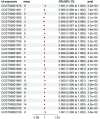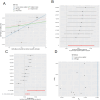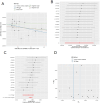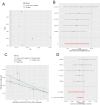Mendelian randomization analysis of immune cell characteristics and genetic variants in cervical cancer risk: a genome-wide association study
- PMID: 40514605
- PMCID: PMC12165937
- DOI: 10.1007/s12672-025-02876-7
Mendelian randomization analysis of immune cell characteristics and genetic variants in cervical cancer risk: a genome-wide association study
Abstract
Background: Cervical cancer remains a significant global health concern, with both genetic and immunological factors potentially influencing susceptibility. This study aimed to investigate the causal relationships between immune cell characteristics, genetic variants, and cervical cancer risk using Mendelian randomization (MR) analysis.
Methods: We utilized genome-wide association study (GWAS) data from the UK Biobank, comprising 475,638 participants of European descent with approximately 24.2 million genetic variants. Instrumental variables were selected at a significance threshold of 1 × 10^-5 for immune characteristics.
Results: Forest plot analysis of genetic variants revealed minimal associations with cervical cancer risk, with most odds ratios close to 1.000 despite some statistically significant findings (p < 0.05). MR analyses demonstrated consistent negative correlations between SNP effects on certain immune cell populations and cervical cancer risk, though effect sizes remained small. Multiple MR methods produced similar summary estimates, suggesting no substantial causal relationship between the studied immune cell characteristics and cervical cancer susceptibility.
Conclusions: This comprehensive MR analysis found limited evidence for causal associations between immune cell-related genetic variants and cervical cancer risk. While some statistically significant relationships were observed, the effect sizes were notably small, indicating that these genetic determinants of immune.
Keywords: Cervical cancer; GWAS; Genetic variants; Immune cells; Mendelian randomization; Single-cell RNA sequencing; T cells.
© 2025. The Author(s).
Conflict of interest statement
Declarations. Competing interests: The authors declare no competing interests. Clinical trial number: Not applicable. Ethical approval: Not applicable. Consent to publish: All authors agree to publish this article. Consent to participate: Not applicable.
Figures







Similar articles
-
Mendelian randomization reveals limited causal effects of genetic variants on cervical cancer risk: insights from immune cell populations.Discov Oncol. 2025 May 29;16(1):944. doi: 10.1007/s12672-025-02819-2. Discov Oncol. 2025. PMID: 40439950 Free PMC article.
-
The phenotypic and genetic association between endometriosis and immunological diseases.Hum Reprod. 2025 Jun 1;40(6):1195-1209. doi: 10.1093/humrep/deaf062. Hum Reprod. 2025. PMID: 40262193 Free PMC article.
-
The Causal Relationship Between Opioid Use and Obstructive Sleep Apnea: A Bidirectional Mendelian Randomization Study.Pain Physician. 2025 Mar;28(2):E147-E156. Pain Physician. 2025. PMID: 40168564
-
[Genetic Causation Analysis of Hyperandrogenemia Testing Indicators and Preeclampsia].Sichuan Da Xue Xue Bao Yi Xue Ban. 2024 May 20;55(3):566-573. doi: 10.12182/20240560106. Sichuan Da Xue Xue Bao Yi Xue Ban. 2024. PMID: 38948277 Free PMC article. Chinese.
-
Vasectomy and prostate cancer risk: a pooled of cohort studies and Mendelian randomization analysis.BMC Cancer. 2025 Feb 24;25(1):332. doi: 10.1186/s12885-025-13750-8. BMC Cancer. 2025. PMID: 39994603 Free PMC article.
References
-
- Hamada K, Yamanoi K, Hayashi N, Kotani Y, Matsumoto H, Horikawa N, Abiko K, Yamanishi Y, Iemura Y, Taki M, et al. Re-evaluating prognostic factors for cervical cancer with lymph node metastasis: a Japanese multicenter cohort study based on FIGO 2018. Int J Clin Oncol. 2025;30(3):584–92. - PubMed
-
- He Y, Qiu Y, Yang X, Lu G, Zhao SS. Remodeling of tumor microenvironment by cellular senescence and Immunosenescence in cervical cancer. Semin Cancer Biol. 2024;108:17–32. - PubMed
LinkOut - more resources
Full Text Sources
